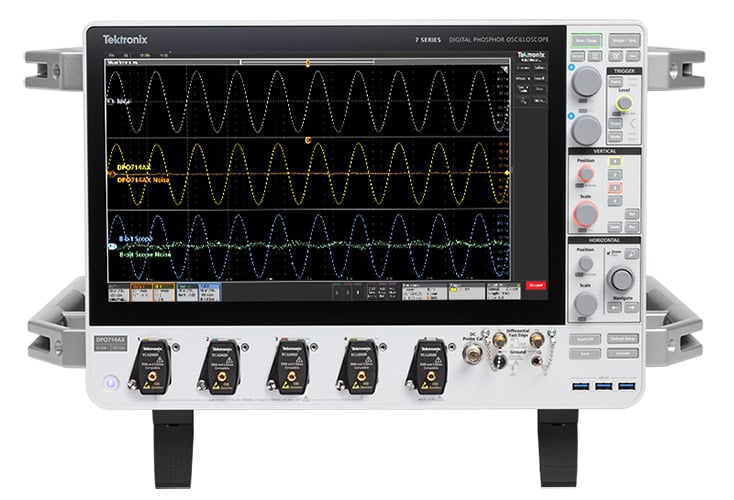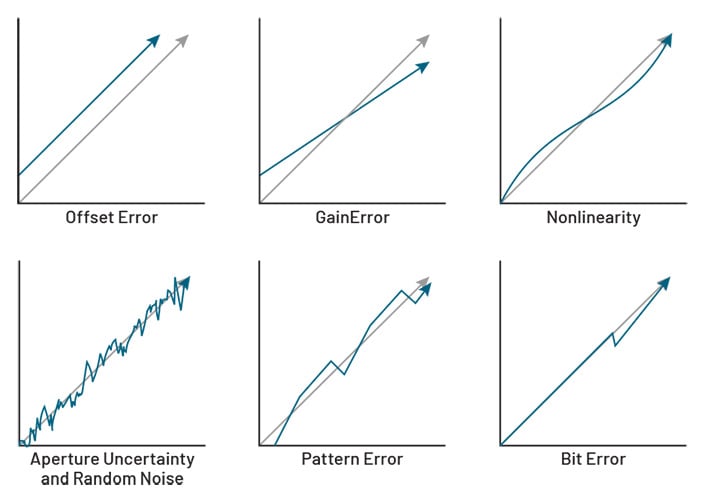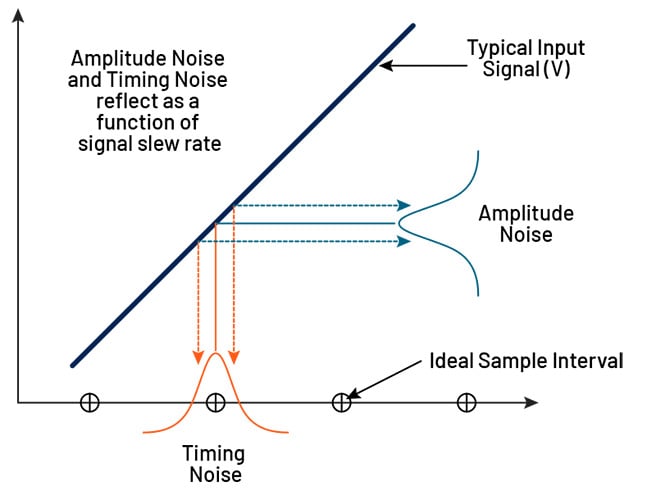Understanding ENOB (Effective Number of Bits) in Test and Measurement Equipment

ENOB — the Practical Measure of ADC Accuracy
Leading-edge electronic systems are becoming faster, denser, and more complex. Engineers working on next-generation wireless, automotive radar, medical imaging, and high-speed computing are all pushing the boundaries of performance. As a result, testing these systems isn’t easy - signals are higher in frequency, denser in modulation, and more sensitive to errors. That makes the accuracy, precision and sensitivity of your test instruments more important than ever.
Most test and measurement instruments—from oscilloscopes to digitizers to spectrum analyzers—rely on analog-to-digital converters (ADCs) to capture real-world signals. These ADCs convert analog waveforms into the digital domain for measurement, analysis, and storage. However, there is a caveat: converting from analog to digital is never perfect. Every ADC introduces some level of error, and different errors add up in complex ways.
Instrument datasheets often run dozens of pages listing specifications for noise, distortion, linearity, jitter, resolution, and more. For engineers, who sometimes have varying experience levels in test engineering on its own, trying to translate all of these into a single understanding of “How good is this instrument?” can be overwhelming. That’s why the IEEE
developed the concept of Effective Number of Bits (ENOB)—a single, powerful figure of merit that captures the real-world performance of a digitizer or oscilloscope.
What is ENOB (Effective Number of Bits)?
ENOB (effective number of bits) quantifies an ADC's real-world resolution by converting its measured signal-to-noise-and-distortion ratio (SINAD) into the equivalent number of ideal bits. ENOB compresses noise and distortion into one intuitive number that expresses an actual converter’s performance as the equivalent resolution of an ideal N-bit ADC.
ENOB vs ADC Resolution: Bits on Paper vs Bits in Practice
It’s easy to assume that the higher the resolution of an ADC, the better. A 12-bit oscilloscope must be better than an 8-bit oscilloscope. In practice, that is not always the case.
Resolution is the number of digital steps an ADC could represent in theory. For example, a 12-bit ADC has 4,096 discrete steps, while an 8-bit ADC has just 256. But that’s only part of the story. In practice, noise, jitter, and distortion mean the effective resolution is always lower.
That’s where ENOB comes in. If a 12-bit oscilloscope specifies an ENOB of 8, its performance is roughly equivalent to an ideal 8-bit converter. In other words, those “extra” four bits of resolution aren’t really helping you measure your signal. Sometimes, an 8-bit oscilloscope with a higher ENOB at the frequencies you care about can outperform a more expensive 10- or 12-bit instrument.

Figure 1 illustrates the unavoidable quantization error—the ±½ least significant bit (LSB) uncertainty—that defines the noise floor of an ideal digitizer. This sets the stage for ENOB as a more meaningful way to describe real performance.
Where Errors Come From (And Why ENOB Matters)
Real-world digitizers add error on top of the bare ±½ LSB quantization floor. Sources of these errors include the following:
- Offset error: A constant shift in the output code.
- Gain error: Incorrect scaling of the input signal.
- Nonlinearity: Deviations from a perfectly straight transfer function.
- Aperture uncertainty (sample jitter): Timing variations during sampling.
- Random noise: Thermal and other sources of unpredictability.
- Digital errors: Data loss due to metastability, missing codes, etc..
Figure 2 provides a helpful visualization of the types of errors one can encounter in digitizing systems.

Figure 2: Errors associated with non-ideal digitizing.
A particularly important source is aperture uncertainty, which is also known as sample jitter. This refers to the sample-to-sample timing variation inherent in the analog-to-digital conversion process. While some sources may use "sampling jitter" as a broad term for any timing variation in a sampling system, "aperture uncertainty" refers explicitly to the non-ideal timing of the sampling mechanism within the converter itself.
Imagine sampling a sine wave at its zero crossing. If the signal is slow, even a little jitter doesn’t matter much. However, as the frequency increases, the slope at the zero crossing becomes steeper, and a tiny amount of timing errors translates into a much larger amplitude error.
Figure 3 illustrates how jitter impacts measurements, especially at higher frequencies. This is a key reason why ENOB tends to decrease as bandwidth increases.

Figure 3: Aperture uncertainty or sample jitter.
All these sources of error reduce the instrument’s usable resolution. Instead of trying to evaluate each error separately, ENOB bundles most of them into a single figure of merit.
How ENOB Is Calculated
The formal definition of ENOB comes from comparing a real ADC’s performance to that of an ideal one. The most common formula is:
ENOB = (SINAD – 1.76) / 6.02
In this case, SINAD (Signal-to-Noise and Distortion) is a measure of how “clean” the digitized signal is; the 1.76 term accounts for quantization noise in an ideal converter; and the 6.02 term converts decibels (log base 10) into bits (log base 2).
Put simply, ENOB tells you how many effective bits your converter provides in practice. For example, while your oscilloscope’s ADC may nominally have 12 bits, the effective number might only be 9.5 bits, which would be equivalent to a perfect (theoretical) 9.5-bit device. Thus, ENOB provides us with a powerful, “apples-to-apples” method for comparing instruments.
Measuring ENOB in Practice
How do engineers measure ENOB? At a high level of abstraction, the process for an oscilloscope, for example, is as follows:
- Feed in a high-quality sine wave. The signal source must be significantly cleaner than the digitizer under test to avoid masking instrument errors. To ensure meaningful results, use an amplitude that is as close as possible to the full-scale input range without clipping—typically about 90% of full scale for Tektronix oscilloscopes (compared to ~80% used by some other vendors). Note that definitions of “full scale” may vary: Tektronix and Rohde & Schwarz define it as 10 vertical divisions, whereas Keysight and Teledyne LeCroy use 8 divisions. Testing near full scale is important, as errors such as sample jitter and harmonic distortion increase with signal amplitude.
- Capture the waveform (the oscilloscope digitizes the signal).
- Fit an ideal sine wave (a perfect mathematical sine wave is compared against the digitized one).
- Calculate the difference (noise and distortion are extracted, and SINAD is computed).
- Convert SINAD to ENOB (the formula shown earlier returns the effective resolution).
These tests should be repeated at steps through the frequency range to generate an ENOB curve across the instrument’s bandwidth, thereby capturing effects that vary with frequency, like sample jitter, distortion, and interleave errors.
The important takeaway here is that ENOB isn’t just a single number—it changes with frequency and signal conditions. This is why published ENOB plots are so helpful when evaluating oscilloscopes.
Why ENOB is Critical in Test & Measurement
ENOB is a critical metric for engineers and designers. Key reasons include the following:
- Clarity in specifications: Instead of wading through dozens of error terms, ENOB gives a single, consolidated view of digitizer accuracy.
- Better instrument selection: A higher-bit instrument isn’t always better. Sometimes, a modest 8-bit oscilloscope with excellent ENOB is a smarter investment than a pricier 12-bit alternative with poor ENOB at the frequencies you care about.
- Confidence in your results: When debugging a high-speed interface, analyzing a radar chirp, or verifying a medical waveform, ENOB indicates whether your instrument can really “see” what’s happening.
- Efficiency in storage and processing: If your system’s ENOB is 7 bits, storing 16-bit data doesn’t buy you anything except wasted disk space and slower processing.
In short, ENOB provides a practical, decision-making tool for engineers working in today’s demanding environments.
The Tektronix Advantage
At Tektronix, ENOB is treated as a core design priority. Our oscilloscopes and digitizers are engineered to deliver high effective bits across wide bandwidths, so you can capture signals with confidence.
Tektronix instruments consistently achieve industry-leading ENOB values, providing engineers with improved test margins and enhanced clarity of insights. Just as importantly, Tektronix makes ENOB measurement methods transparent. Detailed application notes and videos demonstrate exactly how performance is characterized, ensuring that what you see on the screen accurately reflects real-world performance.
For engineers balancing cost, performance, and reliability, this means you don’t have to second-guess whether your instrument is giving you the whole picture. With Tektronix, ENOB performance is transparent and dependable, making all the difference when working on mission-critical designs.
ENOB As a Critical Metric
In the world of high-performance electronics, the number of bits on a datasheet doesn’t tell the whole story. Effective Number of Bits (ENOB) is the metric that reveals how many of those bits are truly usable once noise, jitter, and distortion are accounted for.
By focusing on ENOB, engineers can make smarter choices about which instruments to use, avoid being misled by raw resolution numbers, and gain confidence in their measurements.
Tektronix oscilloscopes and digitizers stand out for their excellent ENOB performance, ensuring you get the clarity and accuracy you need to tackle today’s toughest design challenges.


